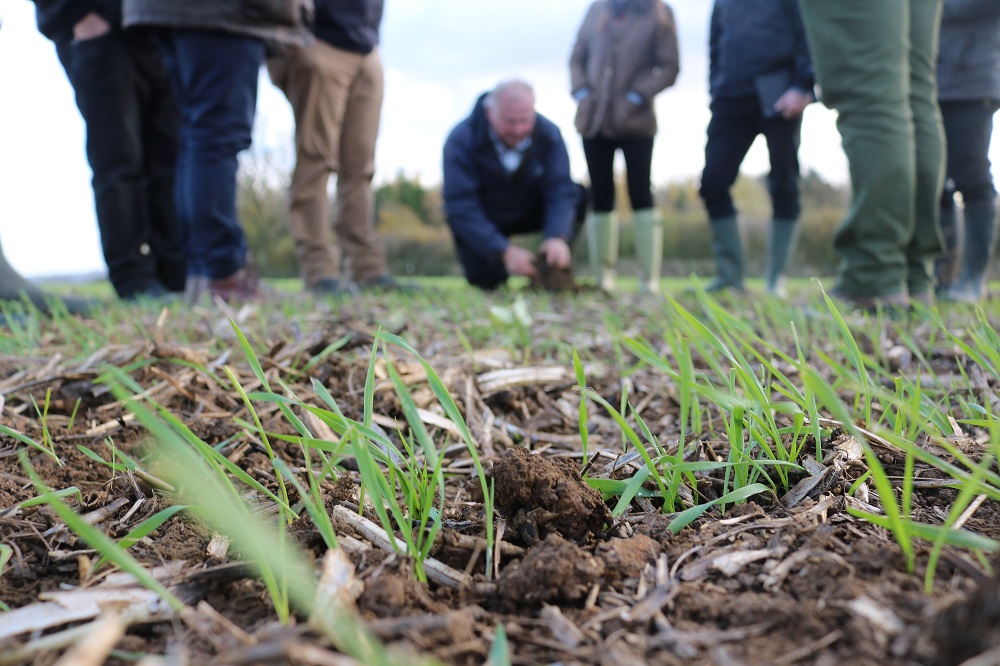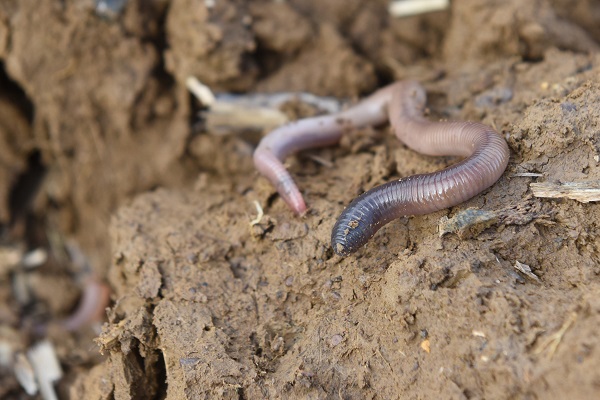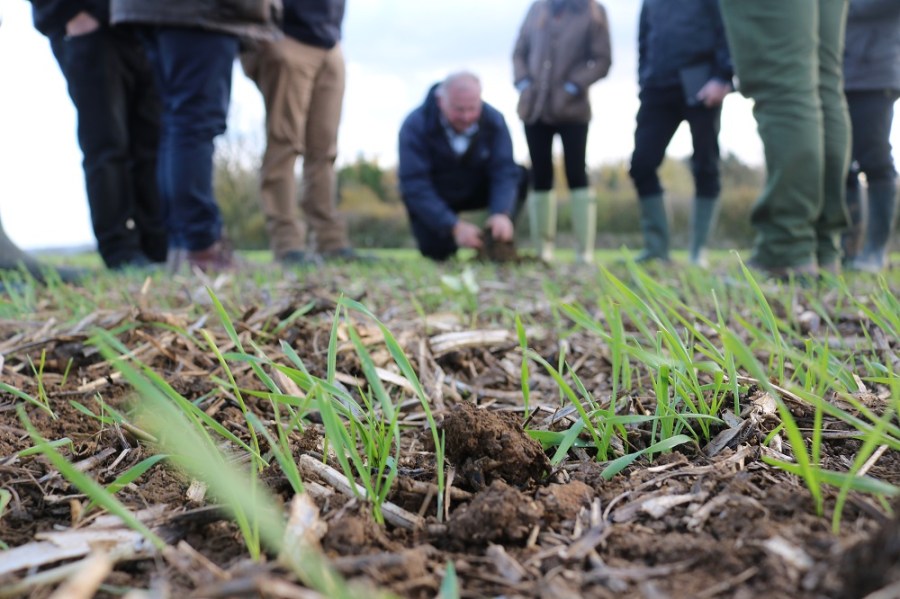
A group of growers from across the UK are on a quest to find out more about how rooting affects crop growth and ultimately yield. CPM joins them as initial assessments are made of on-farm trials that have recently emerged.
A stronger rooting potential can get over most challenges.
By Tom Allen-Stevens
As Phil Jarvis leads the group of growers down through the medium heavy Leics field of winter wheat, that has received three different seed dressings, the challenge is to pick out which is which. But the truth is, the lines of Shabras that catch the afternoon sun all have that late autumn vibrancy you look for, and Phil’s clearly pleased with how the crop’s kicked off from a relatively late start.
But what he’s really interested in, and why the group has come together, is what’s happening beneath the surface. “There’s nothing better than seeing a healthy crop established, but you have to understand everything that’s going on in the soil to achieve that,” says Phil. “A stronger rooting potential can get over most challenges, but I’d rather it was the soil biology or the crop itself that provided that, rather than an extra cultivation pass.”

The crops across all of Phil Jarvis’ in-field trials have established well, but he’s really interested in what’s happening beneath the surface.
This strikes a chord with John Haynes, who farms on the Essex/Herts border and has recently knocked oilseed rape out of his cropping plans. “It’s turned the rotation on its head and we’re now growing a large area of spring crops. But that presents us with the conundrum that the majority of first wheats are established after late-harvested crops,” he notes.
Chris Leslie, farming the Whittingehame Estate in East Lothian, Scotland, is aiming to get a better establishment from minimum cultivation passes through his “difficult red” heavy Humbie soils. “By early autumn, it’s very plastic, so hard to get a seedbed,” he says.
Near Basingstoke in Hants, David Miller is relying more than most on rooting power – following seven years’ experience with cover crops, he’s now taken his loam over chalk soils fully down the direct-drilling route. “The question I have is what we can do with the wheat types we currently have, that may not be best suited to the conservation agriculture we’re trying to achieve.”

Pores, created by soil organisms such as earthworms and previous crop roots, play an essential role in compact soils.
They’re among a core group of growers who have established on-farm trials this autumn in a bid to unearth some of the secrets of how roots develop (see below). It’s part of Root Matters, an initiative from CPM and Syngenta, that aims to bring to the surface expert advice and relevant research that’ll help improve crop growth, and explore how this is put into practice.
Joining them on the Allerton Farm, a 333ha arable farm that aims to combine productive farming with wildlife conservation, is Dr Christina Clarke from ADAS, who brings with her results and summaries on recent research into rooting. As growers push wheat yield potential from 10t/ha to 15t/ha, this increases crop water demand, she points out. That’s where roots, especially deeper roots, step in to keep the crop fed, prolonging green leaf area, producing a greater biomass and sustaining grain filling.
So how do you achieve a crop with the right root architecture? “It’s influenced by both genotype and environment,” she explains. “You need the trait to start with, but roots will go and explore.”
Recent research carried out by ADAS (White et al. 2015), however, has indicated current wheat crops don’t have the deep roots they need to fulfil their yield potential. For sufficient uptake of soil water, a wheat plant needs at least 1cm of root length per cm3 of soil – known as the critical root length density (RLD). “During later growth stages in particular, the majority of water uptake comes from the deeper soil layers. But current wheat crops aren’t producing adequate roots below 40cm,” notes Christina.
These are the average results from field studies, she adds, with the worst crops having an RLD below the critical minimum in the top soil. What’s more, a comparison with similar studies, carried out in the 1970s and 80s, reveals that RLD has declined significantly, and that previous wheat crops achieved a critical RLD at an average depth of 90cm.
Don’t underestimate the impact this has, stresses Christina. “Differences can look small, but in terms of water uptake they can be large, especially when RLD falls below the critical minimum. Higher RLDs are also needed for less mobile nutrients, such as phosphate.
“The difference in yield between a crop with minimum and maximum RLD on a silty loam soil according to our studies is 3.5t/ha.”
So have we blindly bred for reduced rooting, she asks? “There has been a shift since the 1990s in breeding more for above-ground biomass. Wheat varieties nowadays have larger flag leaves, more grains per spikelet and a higher thousand grain weight.”
This shift in allocation may have come at the expense of root growth, however – a crop may have all the right attributes above ground to capture sunlight and present perfectly formed ears to the combine harvester, but studies have shown that varieties differ in when they shift from allocating resource from root to shoot. The concern is that many wheats don’t put down an adequate root architecture and all their potential goes to waste.
Phil suggests that a shift in cultivation practice may have contributed to rooting restrictions. “In many cases, farmers have neglected drainage since the 1970s and 80s. With less ploughing and subsoiling, we’ve probably brought compaction higher up in the soil profile.”
David believes worms and cover crop roots are helping improve rooting capacity in his situation.
Soil compaction, biology and management definitely have an effect, confirms Christina. “Soils with a penetration resistance higher than 2-2.5MPa will impede rooting. Pores, created by soil organisms such as earthworms and previous crop roots, play an essential role in compact soils. Below 60cm in soil with a penetration resistance higher than 5MPa, studies have found 85-100% of roots following existing soil pores.”
Soil type is another crucial factor that affects the supply of water, or water-holding capacity (WHC). Wheat roots may typically explore to a 2m depth, but 1.5m of deep sandy loam soil will have a WHC of 250mm, compared with over 300mm for a silty clay loam. “Roots will explore and extract water from rock, especially chalk, so shallow soils, such as those of the Yorks and Lincs Wolds, aren’t necessarily a limitation,” she adds.
Root architecture plays an important role, and this is affected by both genotype and environment. “Root angle is related to rooting depth, so cultivars with a high lateral spread won’t root so deep, which gives them less drought tolerance. But ground conditions will also affect root angle, and basal roots may choose to explore horizontally, rather than vertically. Finer roots mean a higher RLD, while thicker roots are better for penetration.
“In all cases, crop establishment and vigour are vitally important for initial stages of root development,” stresses Christina. And this carries right through the season, she adds. “If you want extra yield, this won’t come for free – the crop has to find it from the soil, and to do that, it needs extra rooting ability.”
Managing measurements
A simple crop inspection won’t tell you how your roots are performing. So how can you easily assess the crop and gauge progress? “Methodology does influence your conclusions,” notes Christina. “The gold-plate method to measure RLD is to take soil cores, but this costs £1000s and requires experienced scientific input.”
New techniques are available, however, that growers can carry out themselves. “Shovelomics” is a more rapid method, which involves digging up a number of plants to a depth of 10-20cm and carefully extracting the root crowns. Clean these off, taking care to preserve the roots, and then inspect what you have.
“You’re looking to assess root angle, root system size, maximum width and diameter. If you take pictures, there is now special imaging software that will make these assessments for you,” she notes.
You can also use above-ground traits as “proxies” to indicate root proliferation. “NDVI (Normalized Difference Vegetation Index) data can tell you a lot about your roots. Specific wavelengths are related to water absorption, and canopy temperature and the time taken for the crop to senesce are useful properties to measure.”
Soil moisture is another proxy for rooting density, she adds, and this can easily be measured using soil moisture probes or via electromagnetic induction. “But these proxy methods come with caveats as the crop may be reacting to factors unrelated to rooting.”
Vibrant start for on-farm trials
It’s been a kind autumn, and the 12 growers involved in the Root Matters field trials have all started the season with good establishment. All growers are growing winter wheat varieties dressed with Vibrance Duo (sedaxane+ fludioxonil), to see how it performs alongside the farm standard, or a specific situation under investigation. Many of the growers have chosen to use Shabras as their variety for the trial.
Photos of the trials have been taken to gauge speed of emergence, while plant counts at early and 100% emergence record the level of success. In some cases, tiller counts have already been taken and plants dug up to assess roots and shoots.
“In every single case, the Vibrance Duo-treated crop emerged earlier than wheat dressed with Redigo (prothioconazole) or Redigo Pro (prothioconazole+ tebuconazole),” reports Syngenta field technical specialist Jonathan Ronksley.
In East Lothian, Chris Leslie has the challenge of a tight rotation, and a narrow cultivation window on his heavy Humbie soils. “We don’t grow any barley – winter wheat follows oilseed rape or spring oats.”
In the field trial, he’s pitched Grafton alongside Shabras, with both crops treated with Vibrance Duo. Some of the Shabras is treated with Redigo as a comparison. “It follows spring oats, which were combined, with the straw chopped and we then hit the field with a straw rake.”
The farm’s following a low-disturbance routine, with a Horsch cultivator fitted with Tilso tines taken through in Aug, and then the ground’s left until the crop’s drilled with the farm’s Väderstad Rapid. This went in on 23 Oct.
“Our soils are very plastic – you grow in inches when you walk across a field. This makes rapid establishment a key priority.” Photos taken on 6 Nov show a distinct difference, with the Vibrance Duo Shabras quicker off the mark than the crop treated with Redigo. Initial assessment of root weight suggests the dressing has helped the crop put double the growth below ground than the standard dressing.
Over the seven years David Miller’s grown cover crops on his loam over chalk flinty soils in Hants, he’s made a wholesale change in crop type sown. “We used to grow a lot of oil and tillage radish, but had problems with slugs, so now we major on rooting, growing lupins, vetches and berseem clover. We’ve also now gone to no till, with a Cross Slot drill, and that’s been a massive learning curve.”
His Shabras was sown after spring wheat on 5 Oct. “The Vibrance Duo area emerged visibly earlier than the crop treated with Redigo,” he reports. Seedling assessments 19 days after drilling reveal it also put on 20% more biomass.
John Haynes has given his Vibrance Duo-treated Shabras something of a challenge. “The field’s called The Dump, and the name reflects how easy it is to farm. Now we’re not growing OSR, we’ve more second wheats, and this was drilled late, on 23 Oct.”
The field was ploughed, rolled twice, received a pass with a Väderstad Rexus, power-harrowed, drilled and rolled again. “The priority for us is doing what we can to get wheat away early, given that much of the area goes in late. The Dump also has very poor soil, but the crop has emerged well,” he reports.
Jonathan confirms initial assessments across the UK are indicating similar results. “We’d expect Vibrance Duo to perform noticeably better in late-drilled crops. To be fair, this year’s not been much of a challenge for it – last year we found it delivered an average yield benefit over Redigo-treated crops of 660kg/ha from Nov and Dec-drilled sites.”
Approved for use on winter wheat, rye, triticale and spring oats, Vibrance Duo is the first seed treatment from Syngenta that contains an SDHI, and has label clearance for control of a range of seed-borne diseases. But years of testing under controlled conditions have revealed the treatment also gives the crop a rooting advantage. Jonathan’s carried out field trials that have shown this results in an average 450kg/ha benefit, or more than three times return on investment.
Another interesting result he pulls out was a Nov-drilled crop near Wilbraham, Cambs, hit by drought stress during March and April. “You could see the Redigo side was really suffering, and when it came to harvest, the yield difference was 800kg/ha,” he reports.
Root Matters
Root Matters is an initiative from CPM and Syngenta that aims to unearth some of the secrets of how a crop develops beneath the soil surface.
Together with a core group of growers, we’re looking at how to conduct simple assessments of crop and soil health. We’re exploring the implications of agronomy decisions on root mass and plant stress management, and the interaction of this with variety choice. It combines ‘citizen science’ from the group, with practical field trials at Syngenta’s Innovation Centres, through to high level technical R&D.
The aim of this interactive initiative is to develop practical solutions and information to help farmers get more from their wheat crops. We hope to deliver a better knowledge and understanding of crop rooting systems, and work together to develop practical solutions to help farmers get more from their wheat crops.
For more, go to www.syngenta.co.uk/root-matters or follow progress on Twitter – #RootMatters.




